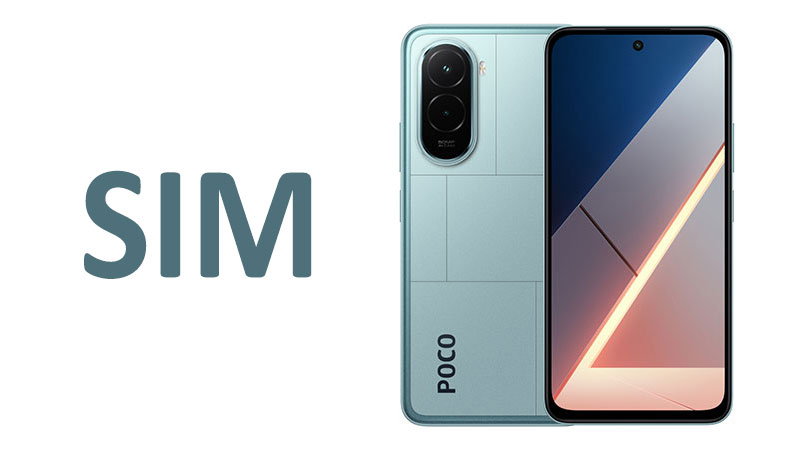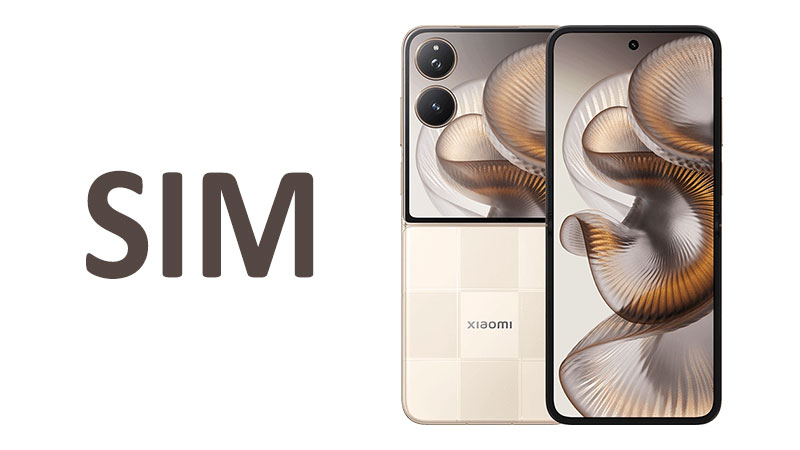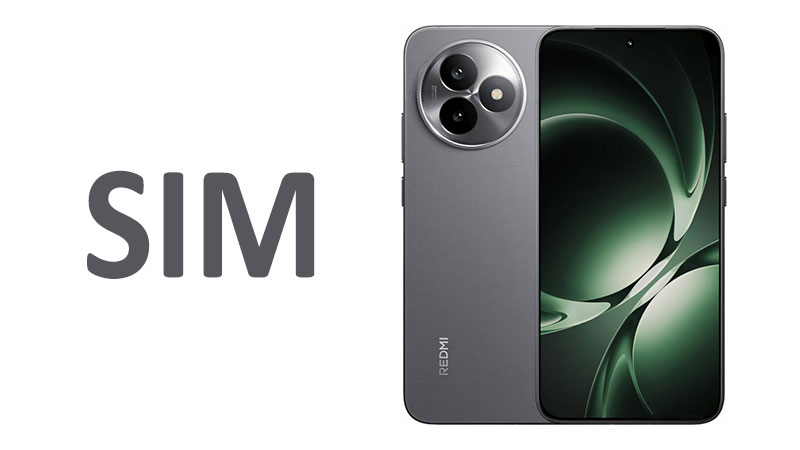The Xiaomi Poco M7 Plus SIM configuration is a crucial element for modern smartphone users. This comprehensive analysis dives into the Dual-SIM capabilities and the full suite of connectivity features. The Poco M7 Plus is designed for demanding global users. It offers a strong blend of high-speed wireless and versatile legacy connections. Understanding these specifications is essential. Buyers must know how the device supports their digital life. This article explores every technical detail, user advantage, and market comparison. We will ensure this guide serves both technical and general audiences effectively.
The Foundation of Flexibility: Dual-SIM Architecture
The Xiaomi Poco M7 Plus supports a robust Dual-SIM setup. Specifically, it uses a Nano-SIM + Nano-SIM configuration. This means the device can simultaneously hold two distinct physical SIM cards. This arrangement is highly beneficial for various user scenarios.
Understanding the Nano-SIM + Nano-SIM Setup
This configuration allows for true flexibility. Users can run two separate phone numbers on one device. Each SIM operates independently on the network. They both remain active for calls and texts at the same time. The user chooses which SIM handles data, calls, and messages. This selection can be changed easily within the phone’s settings.
It is important to note the physical design. The Poco M7 Plus does not feature a hybrid SIM slot. Hybrid slots often force a choice between a second SIM or expandable storage. The dedicated Dual-SIM tray is a significant user convenience. It eliminates this common compromise. Users can enjoy two network connections and still use the dedicated microSD slot if available on the model. This makes the Poco M7 Plus a strong competitor in this specific area.
Specialized Comparison: Dual-SIM vs. Hybrid Slots
Previous Poco models or competing mid-range smartphones often use a hybrid slot. This setup accepts either a second SIM or a microSD card. It forces a tough decision for users needing both dual connectivity and extra storage. The dedicated Nano-SIM + Nano-SIM structure on the Poco M7 Plus is a clear upgrade. It addresses a major user pain point directly. This feature positions the Poco M7 Plus as superior for international travelers or professionals. These users frequently manage multiple lines and need ample local storage.
Pros and Cons of Dual-SIM
There are clear advantages to this Dual-SIM approach. The primary benefit is cost efficiency. Users can separate business and personal contacts easily. They can also mix different carrier plans. For example, one SIM could handle cheap calls. The other SIM could manage high-speed data. International travel also becomes much simpler. Travelers can keep their home SIM active for essential services. They can simultaneously use a local SIM for affordable data rates.
However, there are minor drawbacks. Managing two numbers requires a slight learning curve. The battery life might see a marginal decrease. This happens because the phone constantly connects to two networks. Furthermore, if only one SIM supports 5G, the other SIM will be limited to slower speeds. Users must consider these small trade-offs for the convenience provided.
Next-Generation Speeds: GSM, HSPA, LTE, and 5G Technology
Connectivity technology defines the mobile experience. The Poco M7 Plus supports a comprehensive range of network standards. These standards include GSM, HSPA, LTE, and the crucial 5G technology. This wide compatibility ensures users stay connected almost anywhere.
The Power of Integrated 5G Connectivity
The inclusion of 5G is the defining connectivity feature. 5G networks offer substantially faster download and upload speeds. Latency is also dramatically reduced with 5G. This translates into seamless high-definition video streaming. Online gaming becomes much more responsive. Large file downloads complete in seconds, not minutes.
This advanced technology future-proofs the device. As 5G coverage expands globally, the Poco M7 Plus is ready to utilize it fully. Buyers looking for longevity in their smartphone purchase must prioritize 5G support. This makes the phone a sound investment for the coming years.
Specialized Comparison: 5G vs. LTE Performance
LTE, or 4G, currently provides reliable service worldwide. It delivers acceptable speeds for most daily tasks. However, 5G offers a generational leap in performance. 5G speeds can often exceed 1 Gbps under ideal conditions. Typical LTE speeds might range from 50 to 150 Mbps. This vast difference affects tasks like cloud computing and real-time collaboration. The Poco M7 Plus handles both standards expertly. It automatically switches to the fastest available network. This seamless transition ensures optimal user experience whether in a rural LTE area or a dense urban 5G zone.
Buyer’s Guide to 5G Considerations
A buyer needs to know the Poco M7 Plus supports the necessary 5G bands in their region. Network compatibility is always market-dependent. They should verify local carrier support. The phone’s 5G capability is only as good as the local network infrastructure. However, the phone’s hardware is fully ready. Users benefit from the newest cellular technology available. This ensures they get maximum throughput for data-intensive applications.
Wireless Local Area Network (WLAN) Mastery
Beyond cellular networks, strong Wi-Fi is essential. The Poco M7 Plus features Wi-Fi 802.11 a/b/g/n/ac. Crucially, it also supports dual-band operation. This combination provides fast and stable internet access at home or in the office.
Deconstructing Wi-Fi 802.11 a/b/g/n/ac
This alphabet soup represents many years of Wi-Fi evolution.
- 802.11a and 802.11g were earlier, slower standards. They operate on the 5 GHz and 2.4 GHz bands, respectively.
- 802.11n (Wi-Fi 4) significantly improved speeds and range. It is the first widely adopted standard operating on both bands.
- 802.11ac (Wi-Fi 5) brought substantial speed increases. It operates exclusively on the 5 GHz frequency. This is where the Poco M7 Plus achieves its best wireless speeds.
The device’s support for all these standards guarantees universal connectivity. It can connect to any modern router easily. It also maintains compatibility with older access points.
The Advantage of Dual-Band Wi-Fi
Dual-band support is a crucial feature. It means the Poco M7 Plus can connect to both the 2.4 GHz and 5 GHz frequency bands. The 2.4 GHz band offers a longer range. It is better for connectivity over a distance or through walls. However, this band is often crowded by other devices. These include microwaves and other electronics.
The 5 GHz band provides much faster speeds. It has a higher capacity for data transfer. The trade-off is a shorter effective range. The Poco M7 Plus intelligently manages this choice. It selects the optimal band based on signal strength and congestion. This ensures the most stable and fastest connection possible. Users experience less buffering and quicker loading times. This makes it ideal for streaming high-quality video or large file transfers.
Pros and Cons of Wi-Fi Implementation
The strong Wi-Fi standards are a huge plus. The dual-band feature improves stability and speed substantially. This connectivity suite is competitive in the market. It performs reliably during intense network use.
A minor limitation is the exclusion of 802.11ax (Wi-Fi 6). Wi-Fi 6 is the newest standard. It offers further efficiency and speed gains, especially in crowded environments. While 802.11ac is very fast, the lack of Wi-Fi 6 means the phone is one generation behind the absolute latest Wi-Fi tech. However, for most users, Wi-Fi 5 is more than sufficient for high-speed internet. This feature is a minor constraint, not a major drawback.
Short-Range Wireless: Bluetooth 5.1 and its Benefits
The Poco M7 Plus features Bluetooth 5.1 technology. This is the current standard for robust short-range wireless connections. Bluetooth manages connections for peripherals. These include wireless headphones, smartwatches, and car systems.
What Bluetooth 5.1 Offers
Bluetooth 5.1 introduced several important enhancements. It offers improved speed, increased range, and better energy efficiency compared to Bluetooth 5.0. A key feature of 5.1 is the Direction Finding function. This allows devices to determine the direction of a signal. While not always directly used by the consumer, it improves the precision of location services.
The device supports A2DP and LE profiles. A2DP stands for Advanced Audio Distribution Profile. It is vital for transmitting high-quality stereo audio to wireless headphones. LE means Low Energy. This profile ensures that connected accessories, like fitness trackers, use minimal battery power. This combination results in long-lasting, high-quality wireless audio.
Specialized Comparison: Bluetooth 5.1 vs. Bluetooth 4.2
Many older or budget devices still rely on Bluetooth 4.2. The difference is significant. Bluetooth 5.1 offers four times the range and double the speed of 4.2. Most importantly, it uses much less power due to the Low Energy profile. This means accessories stay connected over longer distances. It also saves the phone’s battery life during continuous use. The upgrade to 5.1 enhances the overall ecosystem experience.
Pinpoint Accuracy: Global Positioning Systems (Positioning)
Accurate navigation is non-negotiable for modern users. The Poco M7 Plus ensures highly precise positioning. It achieves this by supporting four major global navigation satellite systems (GNSS). These are GPS, GLONASS, GALILEO, and BDS.
The Power of Multi-System Support
The simultaneous use of multiple satellite constellations significantly boosts accuracy.
- GPS is the original system, operated by the United States.
- GLONASS is Russia’s system.
- GALILEO is Europe’s highly precise system.
- BDS (BeiDou) is China’s navigation system.
By accessing satellites from all four systems, the phone receives more signals. This minimizes potential signal blockages. It improves location stability in challenging environments. These locations include deep city canyons or dense forests. This multi-system support ensures fast, reliable fix times for navigation apps.
Specialized Comparison: Single vs. Multi-GNSS
A phone relying only on GPS might struggle in urban areas. Buildings can easily block satellite signals. When a phone uses four systems, it always has multiple redundant signals available. This leads to extremely low positioning error. For delivery drivers, hikers, and commuters, this enhanced accuracy is a major selling point. The Poco M7 Plus provides a premium-level navigation experience.
Buyer’s Understanding of GNSS Reliability
Users should be confident in the positioning feature. Whether relying on Google Maps or a dedicated fitness tracker, the accuracy is superior. The robust GNSS package provides stable tracking for fitness activities. It also enables seamless, turn-by-turn navigation in unfamiliar places. This connectivity feature offers genuine utility to travelers and explorers.
Versatile Extras: NFC, Infrared Port, and USB
The connectivity suite of the Poco M7 Plus includes several important secondary features. These often overlooked components add significant utility and convenience to the device. They enhance the phone’s overall value proposition.
NFC for Mobile Payments and Connectivity
The Poco M7 Plus includes Near Field Communication, or NFC. NFC is a short-range wireless technology. It allows devices to communicate when they are within a few centimeters of each other. Its primary function for most consumers is contactless mobile payments. Users can easily link their bank cards. They then use the phone to pay at compatible terminals. This is a massive convenience feature.
It is noted that NFC availability is market and region dependent. Buyers must check local specifications before purchase. Some carriers or regions might disable this feature. For markets where it is active, NFC enables quick data exchange. This includes sharing photos or pairing Bluetooth accessories easily. It streamlines many daily interactions.
The Unique Utility of the Infrared Port
The inclusion of an infrared port is a hallmark feature of many Xiaomi and Poco devices. An infrared port turns the smartphone into a universal remote control. This is a very useful legacy feature. Users can control TVs, air conditioners, projectors, and other home appliances.
The infrared port works by sending specific light signals. These mimic the signals from traditional remote controls. This eliminates the clutter of multiple physical remotes. The functionality is handled through a pre-installed app. This adds a unique convenience not found in most competitor devices. The Poco M7 Plus leverages this simple technology effectively. It adds unexpected value for smart home users.
USB Type-C 2.0: Data and Charging
The Poco M7 Plus uses a USB Type-C 2.0 port. The Type-C connector is reversible and universally accepted. This eliminates the frustration of trying to plug in the cable incorrectly. It provides a reliable connection for both charging and data transfer.
USB 2.0 offers standard data transfer speeds. These speeds cap out at 480 Mbps. While this is adequate for most users, it is not the fastest available. Faster standards like USB 3.0 or 3.1 are reserved for higher-end flagships. Buyers should know this detail. Transferring massive video files may take a bit longer. However, the Type-C port supports modern fast-charging standards. This minimizes the impact of the slower data speed. It remains a robust and highly convenient physical connection.
A Note on the Absence of Radio
The specifications confirm that the Poco M7 Plus does not include an FM radio feature. For many users, this is a non-issue. Music streaming and podcasts have largely replaced traditional radio. However, some users still value the ability to listen to local broadcasts. This is especially true during emergencies or for saving mobile data. The lack of a physical radio tuner means users must rely on internet streaming apps. This detail should be considered by specific user groups.
Comprehensive Summary of Pros and Cons
The overall connectivity package is robust and feature-rich.
Key Connectivity Pros
- True Dual-SIM capability: The Nano-SIM + Nano-SIM arrangement offers maximum flexibility without compromising storage. This is a huge benefit for professionals.
- Future-proof 5G Network Support: Access to the fastest mobile data speeds ensures the device remains current for years. Fast speeds improve the browsing experience significantly.
- Reliable Dual-Band Wi-Fi 5: The support for both 2.4 GHz and 5 GHz bands ensures stable and rapid home internet connectivity. This is vital for streaming.
- Advanced Bluetooth 5.1: Offers faster speeds and superior power efficiency for all connected accessories. Audio quality remains excellent.
- Universal GNSS Support: Quad-system positioning (GPS, GLONASS, GALILEO, BDS) guarantees excellent location accuracy and reliability globally. This is great for navigation.
- Infrared Port Utility: The built-in IR blaster turns the phone into a universal remote control. This is a highly convenient extra feature.
Key Connectivity Cons
- USB Type-C 2.0 Speed: Data transfer is limited to 480 Mbps, which is slower than newer USB 3.x standards. Large file transfers take longer.
- Lack of Wi-Fi 6 (802.11ax): The phone does not support the latest, most efficient Wi-Fi standard. However, the existing Wi-Fi 5 is still very fast.
- No Built-in FM Radio: Users must rely on internet streaming for radio content. This might not appeal to everyone.
- NFC is Region-Dependent: Mobile payment functionality might not be available in all markets. This requires pre-purchase verification.
Essential Points for the Prospective Buyer
Potential buyers must consider how these features impact daily life. The Poco M7 Plus connectivity suite targets the value-conscious power user. This person needs speed and flexibility without the flagship price tag.
The Dual-SIM feature is paramount for those managing work and personal lives. It is a genuine time and money saver. International business travelers benefit immensely from this capability. The robust 5G support ensures the device delivers on performance. Users will notice the speed in gaming, video calls, and large downloads. This technology makes the phone feel modern and responsive.
Consumers should evaluate their need for fast file transfer. If frequently moving gigabytes of data between the phone and a computer, the USB 2.0 limitation is important. For typical users who primarily use cloud storage, the USB speed is perfectly fine. The inclusion of the infrared blaster is a delightful surprise. It adds a practical convenience that competitors often omit. The total package offers a high level of connectivity value. It stands strong against mid-range competitors.
Conclusion: Making an Informed Connectivity Choice
The Xiaomi Poco M7 Plus SIM and connectivity package is extremely well-rounded. It strategically balances modern demands with practical utility. The dedicated Dual-SIM (Nano-SIM + Nano-SIM) setup provides unparalleled user flexibility. It allows easy management of multiple lines and separate billing. The integrated 5G technology ensures high-speed data access for the future. This guarantees a smooth experience for streaming and heavy data use.
Furthermore, the dual-band Wi-Fi and Bluetooth 5.1 are strong performers. They deliver reliable wireless connections for peripherals and home networks. The multi-GNSS support ensures accurate and dependable navigation globally. Minor drawbacks like the USB 2.0 speed are easily manageable for most users. In summary, the Poco M7 Plus offers a comprehensive, flexible, and fast connectivity solution. This phone is an excellent choice for any user prioritizing seamless, modern, and versatile mobile connections. Buyers should feel confident that this device can handle virtually all their wireless needs effectively.
Frequently Asked Questions (FAQ)
1. Does the Poco M7 Plus support two active 5G connections simultaneously?
The Poco M7 Plus is a Dual-SIM phone. It can keep both SIMs active for calls and texts. However, only one SIM can be configured for the active 5G data connection at a time. The other SIM will typically default to 4G or 3G data.
2. Is the USB Type-C port used for fast charging on the Poco M7 Plus?
Yes, the USB Type-C 2.0 port handles both charging and data. While the data transfer speed is limited by the 2.0 standard, the port fully supports the phone’s proprietary fast charging technology. This allows for quick battery replenishment.
3. Can I use the infrared port to control any old TV model?
The infrared port functions as a universal remote. It works with most major brands of TVs, set-top boxes, and air conditioners. Compatibility depends on the pre-installed remote app’s database. Users can usually control devices up to several years old easily.
4. What is the benefit of having four different positioning systems (GNSS)?
Supporting four systems (GPS, GLONASS, GALILEO, BDS) improves location accuracy and reliability. More available satellites mean the phone gets a faster, more stable location fix. This is critical for accurate navigation and mapping, especially in difficult environments.
5. Does the lack of Wi-Fi 6 support significantly affect daily performance?
No, the lack of Wi-Fi 6 is a minor detail for most users. The included Wi-Fi 5 (802.11ac) is incredibly fast on the 5 GHz band. It provides enough bandwidth for all current consumer applications like 4K streaming and high-speed downloads.



